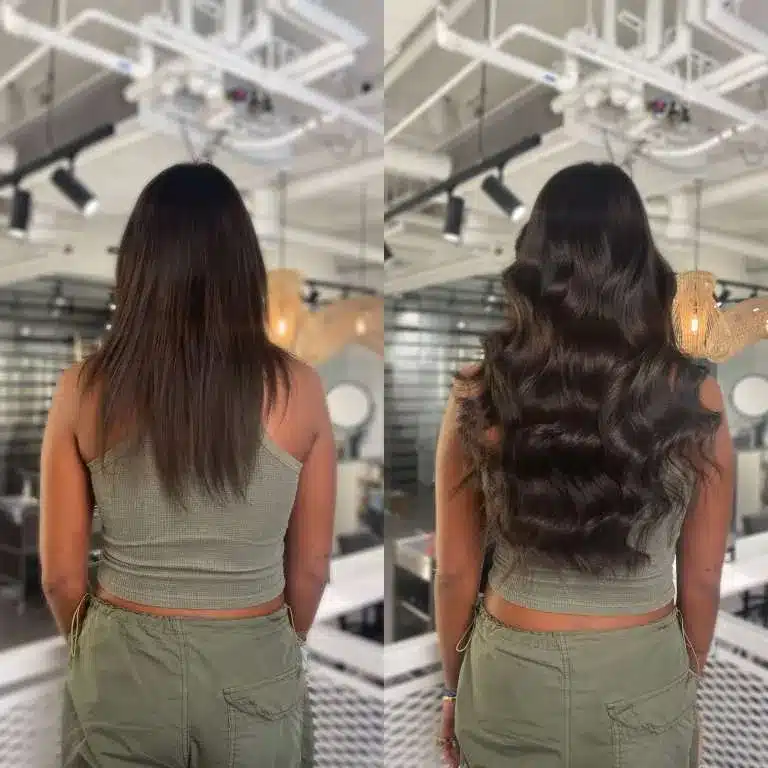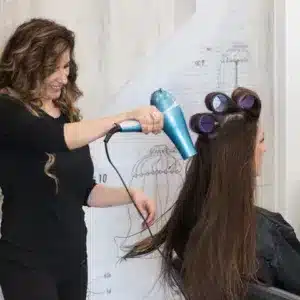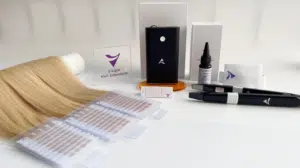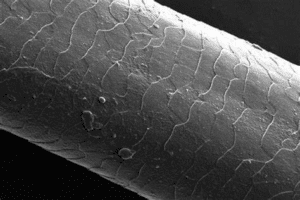Clients want lasting fullness, but they fear damage and long appointments. Confusing answers online make it worse. My role is to advise you with clear, practical guidance you can give to clients.
K tips are not inherently damaging. Risk comes from poor section sizing, late maintenance, low-grade hair, or harsh removal. Recommend quality keratin, full-cuticle hair, clean technique, and on-time removals to protect the base hair.

You want concise answers and steps you can act on. I wrote this as an advisory playbook: clear pros and cons, realistic timelines, reuse rules, cost structure, method comparisons, and a maintenance checklist you can hand to clients.
Are K tips bad for your hair?
People search “are K tips damaging” and worry about heat. That fear is understandable. The real risk is not the method; it is the mismatch between section, weight, timing, and fiber.
K tips themselves do not harm hair when you match strand weight to section size, avoid oils at bonds, schedule 12–16 week removals, and use solvent correctly. “Are K tip extensions bad for your hair?” The short answer is no—bad installs are.

The root cause of most “damage” cases
Many clients ask: do K tips damage hair, are K tips damaging to hair, or does K tips damage hair? Problems usually trace back to four factors. First, overweight strands on fine sections pull as hair grows; recommend 0.5–0.8 g near hairlines and 0.8–1.0 g in denser zones. Second, late maintenance lets bonds ride far from the scalp; friction and tangles rise, and removal becomes difficult. Third, product migration from oils, serums, or conditioners at the root weakens the seal and creates slip-and-knot scenarios. Fourth, poor fiber—acid-washed, mixed, or non-aligned hair—swells and mats under daily heat and washing, then stresses bonds. Good advisory fixes these. Guide your team to weight-match, pre-book removals at 12–16 weeks, keep bond areas product-free, and specify full-cuticle, single-donor hair in every PO.
Simple safeguards you can recommend with confidence
You do not need to “install” to give expert guidance. Recommend a strand-to-section ratio, a bond-safe at-home routine, and a maintenance calendar. Suggest loop-brush technique (support bonds with the other hand), nightly braids, heat protectant, and “no oils at the roots.” Encourage salons to keep a one-page aftercare card and to photograph bonds on day one for quality tracking. When clients and teams follow these simple rules, base hair remains healthy, and long-term satisfaction improves.
K tip hair extensions pros and cons?
Decision makers want clear trade-offs. K tips offer strong control and long wear; they also require skill, time, and careful removal.
Pros include precise placement, small sealed bonds, discreet finish, hot-tool compatibility, and high reuse with full-cuticle hair. Cons include heat at install, longer chair time than tapes, and solvent-based removal.
Advantages you can communicate to clients and buyers
K tips allow micro-customization. Stylists can vary spacing, rotation, and strand weight by zone. Bonds sit small and flat, so updos and high ponies look clean. The sealed keratin point resists light sweat and product drift better than open systems, which helps athletes and frequent washers. With full-cuticle hair, salons can remove, cleanse, re-tip, and reinstall, lowering cost per wear for clients while raising lifetime value for the business. These points are easy to add to your website, price cards, and consultations.
Limitations to plan around—not ignore
Heat during install demands control. The team needs training on temperature, roll speed, and pinch pressure to avoid bulky bonds. Application and removal take longer than tapes, so owners should price time realistically and set client expectations early. Solvent choice matters; cheap solvent leaves residue and creates reapplication problems. The fix is simple: standardize an SOP, time each step, choose one solvent system, and keep a “no-rush” rule for removal and comb-out.

Summary table for quick reference
| Area | Pros | Cons |
|---|---|---|
| Control | Strand-level placement, clean mapping | Skill required for uniform bonds |
| Appearance | Small, flat bonds; discreet in updos | Bonds can bulk if rolled poorly |
| Longevity | Predictable 12–16-week wear | More chair time than tapes |
| Styling | Hot tools OK away from bonds | Heat at install needs discipline |
| Reuse | High with full-cuticle hair + re-tipping | Requires solvent and patient comb-out |
How long do K tip extensions last?
Owners need calendar certainty. Clients want a simple answer. The real range depends on growth, lifestyle, care, and fiber.
Advise a 12–16 week wear window per install. With full-cuticle hair and careful removal, the same hair often supports 1–2 years of reuse across multiple cycles.
What controls the timeline in real life
Hair growth moves bonds away from the scalp. Past 16 weeks, bonds sit in high-friction zones and comfort drops. Active clients—swimmers, gym-goers, frequent washers—may need earlier checks. Home care matters: loop-brush technique, nightly braids, and no oils near bonds extend comfort and appearance. Most of all, fiber quality sets the ceiling. Full-cuticle, single-donor hair keeps alignment and shine under heat and washing, while low-grade hair mats and forces early removals.
A maintenance cadence you can recommend
Propose a two-touch schedule: a quick check at 6–8 weeks to trim flyaways and reinforce education; a full removal at 12–16 weeks with solvent, patient comb-out of shed hair, clarify, dry 100%, re-tip if needed, then re-map rows. This cadence reduces emergency visits, improves retail add-ons, and stabilizes revenue. Make the next appointment before the client leaves. Simple scheduling prevents the “late removal equals damage” loop.
Can you reuse K tip extensions?
Buyers want lower cost per wear. Stylists want consistent results. Reuse is not only possible; it is a core value proposition when the inputs are right.
Yes. Recommend reuse only with full-cuticle hair, clean removal, and fresh re-tipping. The keratin changes each cycle, but the hair fiber remains serviceable when treated well.
What enables safe, repeatable reuse
Reuse relies on three pillars. First, fiber integrity: full-cuticle, single-donor hair resists matting and keeps color better, so the strand remains cosmetically useful. Second, clean chemistry: cosmetic-grade keratin melts evenly and sets hard, then breaks down cleanly with the right solvent. Third, disciplined removal: solvent first, then progressive pressure, then comb-out of shed hair; never scrape or tug. After removal, advise a clarify + dry step to neutralize residue. Re-tip on a dry, clean strand only.

A simple, trackable reuse workflow
- Wear 12–16 weeks.
- Solvent removal; avoid force; comb shed hair fully.
- Clarify strands; dry 100%.
- Inspect mid-lengths/ends; trim if needed.
- Re-tip with consistent keratin size/weight.
- Re-map rows; adjust strand weights by zone.
- Log cycle count, color formula, and client notes.
This loop protects hair, reduces waste, and answers the query do K tips damage your hair? Proper reuse does not. Poor removal does.
How much are K tip extensions?
Leads ask for numbers. They also want value logic, not just price. Separate hair cost from service cost, then show the reuse effect.
Hair cost scales with length and color complexity. Service cost scales with strand count and time. Premium full-cuticle hair raises day-one price but lowers cost per wear through reuse.
Price drivers you should explain up front
Length, weight per pack, and blended shades (rooted, balayage) drive hair cost. Full-cuticle fiber sits higher than generic “Remy,” but it keeps alignment, which reduces tangles and increases reuse cycles. Service pricing should cover consultation, mapping, install, finish, and separate line items for removal and re-tip. Transparent pricing builds trust and reduces pushback at maintenance.
Illustrative price framework (adapt to your market)
| Item | Example Range (USD) | Notes |
|---|---|---|
| 20″ K tip hair, full-cuticle (100 g) | $250–$420 wholesale | Shade complexity and weight drive variance |
| Install service (150–175 strands) | $400–$900+ retail | City, brand tier, and timing matter |
| Removal + cleanse | $120–$250 | Add time for density or overdue sets |
| Re-tip service | $80–$180 | Count-based; include materials |
| Move-up package (remove/re-tip/reuse) | $250–$450 | Loyalty pricing improves retention |
Educate clients on cost per wear. Many accept a higher entry price when they see two to four reuse cycles with premium fiber.
How to apply K tip extensions?
You may not install them yourself, but your guidance shapes outcomes. Give teams a clear SOP and hold them to it. Consistency beats speed.
A safe application follows clean sectioning, controlled heat, quick roll, and cool set. Weight and spacing match natural density. Bonds remain small, smooth, and comfortable from day one.
Tools, prep, and environment
Recommend a neat, repeatable station: heat tool with stable temperature, shields, finger protectors, tail comb, section clips, loop brush, and solvent for corrections. Insist on 100% dry, clean hair before install. Map zones (nape, mid, crown, temples) and respect natural fall. Keep a trolley layout identical for all techs. This reduces errors and speeds training.
Step-by-step with quality gates
- Plan density and rows with the client upright.
- Match section to strand weight; avoid overloading fine zones.
- Place K tip, apply heat as specified; no hovering or overheating.
- Roll quickly into a rice-grain shape; edges smooth, no spikes.
- Cool and check rotation; bonds should not rub each other.
- Keep spacing consistent; avoid stacking and high-friction paths.
- Blend and finish with bond-safe products; document strand count by zone.
Add three quality gates: comfort check (no pinch), visibility check (no show in common partings), and friction check (no bond-on-bond). These small checks prevent callbacks and the “are K tips damaging” complaint spiral.

K tips vs other methods?
Buyers ask for the “best method.” There is no universal best. There is only the best fit for the client, style, and maintenance capacity.
K tips deliver sealed bonds and long intervals. I tips avoid heat and enable micro-moves. Tapes install fast and blend well near the face. Wefts produce large volume quickly with row-based systems.
Consultation-ready comparison
| Feature | K Tip (Keratin) | I Tip (Beaded) | Tape-In | Weft (Sewn/Beaded) |
|---|---|---|---|---|
| Heat at Install | Yes | No | No | No |
| Install Time | Moderate–Long | Moderate | Fast | Moderate |
| Maintenance Interval | 12–16 weeks | 6–8 weeks micro-moves common | 6–8 weeks | 6–10 weeks |
| Updo Visibility | Very discreet | Discreet; beads can flash | Tabs can show if placed too high | Tracks can show in tight updos |
| Removal | Solvent + patient comb-out | Bead openers; quick | Solvent; quick | Beads/threads; quick |
| Best For | Long wear, athletes, updos | No-heat philosophy, frequent adjusters | Speed and soft face framing | Big volume and row control |
| Reuse Potential | High with re-tipping | High with new beads | Moderate; tabs fatigue | High; row reinstall |
Use this matrix to direct clients. When a client fears heat and wants frequent micro-adjustments, recommend I tips. When a client needs fast installs and easy removals, recommend tapes. When a client wants sealed bonds, fewer visits, and tidy updos, recommend K tips.
Care and maintenance checklist?
Clear rules make clients confident. Simple habits protect bonds, reduce tangles, and extend appearance. This is the easiest way to cut “are K tips damaging” callbacks.
Clients should brush daily with a loop brush, avoid oils at bonds, braid at night, and book timely removals. Heat styling is fine away from bonds with protectant.

The habits that move the needle
Share a one-page card or email. Keep it simple. Wash 2–3× weekly with bond-safe shampoo. Condition from mid-length to ends only. Brush morning and night, supporting bonds with the other hand. Dry roots fully after washing; do not leave bonds damp. Sleep in a low braid or silk cap. Style with heat a finger-width away from bonds and always use protectant. Swim with pre-wet hair and a cap when possible; rinse promptly after. No oils or silicone serums at roots. No rough towel drying. Most important, do not miss the 12–16 week removal. Late removals, more than anything else, turn “safe” systems into “are K tips damaging to hair” complaints.
A quick troubleshooting table for front-desk teams
| Symptom | Likely Cause | Suggestion |
|---|---|---|
| Bonds feel bulky | Over-rolled or overweight strands | Book a check; trim bonds; adjust weight next cycle |
| Slipping near temples | Oils at roots / spacing too tight | Clarify; reinforce aftercare; widen spacing |
| Tangles at mid-lengths | Late removal / poor fiber | Remove now; clarify; re-tip; specify full-cuticle |
| Heat “whitening” of bonds | Hot tool too close | Educate distance; use lower tool temp |
My opinion
K tips are safe when weight matches section, bonds stay product-free, and move-ups happen on time. Choose full-cuticle hair, standardize an SOP, and give clients simple rules. You get predictable cycles, clean removals, and strong loyalty.
FAQ
Are K tips damaging to hair?
Not by default. Problems link to overweight strands, late removals, or poor fiber. Control those, and hair stays healthy.
Do K tips damage your hair if you curl often?
No, if you keep hot tools away from bonds and use heat protectant.
Are K tip extensions bad for your hair if you swim?
No. Rinse after, avoid oils at the roots, and dry bonds fully.
Can clients color K tips?
Toning is fine. For major changes, color before bonding or order the correct shade.
How many strands for a full head?
Typical 125–175 strands, based on density and target length.
When should removal happen?
Advise 12–16 weeks. Late removals raise friction and knots.
k tip extensions before and after



CONCLUSION
By being aware of the potential risks and following proper installation and care guidelines, both stylists and clients can enjoy the beauty of K tip extensions without compromising hair health. Emphasizing education, quality products, and regular maintenance will lead to a positive experience and long-lasting results.
Hibiscus Hair Manufacturer has been focusing produce high quality K Tip hair extensions for 25 years and are an industry leader in this field. If you are interested to find a reliable hair extensions supplier, please check for our more details.
KERATIN HAIR





